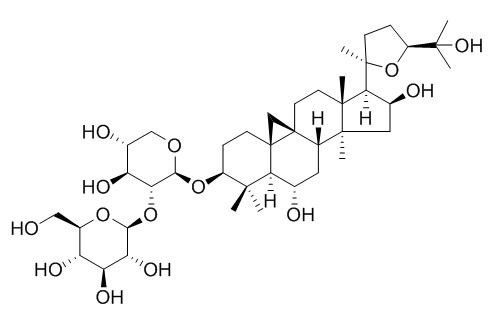Astragaloside III
Astragaloside III has anti-gastric ulcer effects, and exhibits strong growth-promoting effects in cultured GES-1 cells. Astragaloside III can effectively reduce cancer cell survival in vitro and inhibit the tumor growth in vivo, the potential mechanism is the induction of cell apoptosis signaling pathways, suggests that it provides a new therapeutic tool to treat breast cancer.
Inquire / Order:
manager@chemfaces.com
Technical Inquiries:
service@chemfaces.com
Tel:
+86-27-84237783
Fax:
+86-27-84254680
Address:
1 Building, No. 83, CheCheng Rd., Wuhan Economic and Technological Development Zone, Wuhan, Hubei 430056, PRC
Providing storage is as stated on the product vial and the vial is kept tightly sealed, the product can be stored for up to
24 months(2-8C).
Wherever possible, you should prepare and use solutions on the same day. However, if you need to make up stock solutions in advance, we recommend that you store the solution as aliquots in tightly sealed vials at -20C. Generally, these will be useable for up to two weeks. Before use, and prior to opening the vial we recommend that you allow your product to equilibrate to room temperature for at least 1 hour.
Need more advice on solubility, usage and handling? Please email to: service@chemfaces.com
The packaging of the product may have turned upside down during transportation, resulting in the natural compounds adhering to the neck or cap of the vial. take the vial out of its packaging and gently shake to let the compounds fall to the bottom of the vial. for liquid products, centrifuge at 200-500 RPM to gather the liquid at the bottom of the vial. try to avoid loss or contamination during handling.
J of L. Chroma.&Related Tech2017, 252-258
Front Pharmacol.2020, 11:566490.
Front Microbiol.2023, 14:921653.
Indian J Pharm Sci.2022, 84(3):144-151
Molecules.2023, 28(3):1313.
iScience.2024, 4790628.
J Pharm Biomed Anal.2017, 140:274-280
Int J Mol Sci.2019, 20(9):E2244
Chemistry of plant raw materials2021, 1:pp 139-150
Evid Based Complement Alternat Med.2020, 2020:2584783.
Related and Featured Products
Fitoterapia. 2010 Jul;81(5):447-51.
Effects of cycloartane saponins from hairy roots of Astragalus membranaceus Bge., on human tumor cell targets.[Pubmed:
20060881]
For the first time three different natural compounds, isolated from hairy roots of Astragalus membranaceus, cultivated in airlift bioreactor were tested for their cytotoxic potential and apoptosis induction in a panel of human tumor cell lines.
METHODS AND RESULTS:
Root cultures, cultivated in bioreactor gave 18.5 g l(-1) dry wt roots with the highest astragaloside production in vitro up to now - 1.64% (astragaloside I), 1.12% (astragaloside II) and 1.08% (Astragaloside III).
CONCLUSIONS:
In this manner the production in airlift bioreactor can be used as means of reliable supply of cycloartane saponins to extend the research to human clinical studies.
Afr. J. Tradit. Complem., 2015, 12(3):183-6.
Astragaloside III from Astragalus membranaceus antagonizes breast cancer growth[Reference:
WebLink]
Astragaloside III has been used to treat different cancers; however their effect on breast cancer remains unknown.
METHODS AND RESULTS:
The present study examined the effects of Astragaloside III from Astragalus membranaceus on breast cancer cell lines in vitro as well as xenograft in vivo. The results showed that the Astragaloside III could effectively reduce cancer cell survival in vitro and inhibit the tumor growth in vivo. The potential mechanism is the induction of cell apoptosis signaling pathways.
CONCLUSIONS:
We believe that Astragaloside III provides a new therapeutic tool to treat breast cancer.
J Chromatogr B Analyt Technol Biomed Life Sci. 2014 Jun 1;960:43-51.
Component analysis and structure identification of active substances for anti-gastric ulcer effects in Radix Astragali by liquid chromatography and tandem mass spectrometry.[Pubmed:
24780704 ]
This study provided a comprehensive component analysis and structure identification of active substances for the anti-gastric ulcer effects of Radix Astragali.
METHODS AND RESULTS:
The data were generated by organically combining the results from in vivo pharmacodynamic experiments, a cell growth-promoting assay, structure identification, content determination, fingerprinting, and correlation analyses. The fingerprints from high-performance liquid chromatography coupled with a diode array detector (HPLC-DAD) and from HPLC coupled with evaporative light scattering detectors (ELSD) from 95% ethanol extracts of Radix Astragali (ERA) were determined using HPLC-DAD-ELSD. The structures of 16 compounds were identified using ultra-pressure liquid chromatography-electrospray ionization-tandem mass spectrometry (LC-ESI-MS). The contents of these 16 compounds were simultaneously determined in a single run using HPLC-DAD-ELSD. The strength of the anti-ulceration effect of each of the 16 compounds was correlated to its content in the HPLC spectrum using gray relation statistics. The sequence of the contribution from each of the 16 compounds to the anti-gastric ulcer effect was determined. The results showed that ononin, astragalosideIII, and astragalosideIV contributed most to the observed anti-gastric ulcer effects and that these three compounds also exhibited strong growth-promoting effects in cultured GES-1 cells.
CONCLUSIONS:
The results of this study can be used to evaluate the quality of Radix Astragali and to provide a theoretical foundation for its further study.



